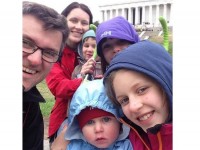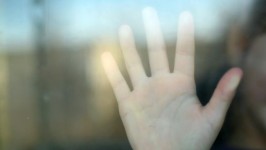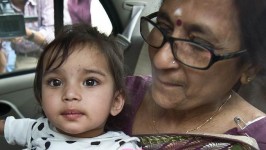A disturbing new case of ‘legal kidnapping’ has cast a spotlight on Norway’s child protection laws
- Details
- Category: International Cases
- Created: Wednesday, 20 April 2016 19:43
- Written by Gavin Fernando - News.com.au

At what point is it necessary to remove a child from his or her parents.
IF YOU stopped by for a visit, you wouldn’t think there was anything out of the ordinary about the Bodnariu family.
Marius Bodnariu is a computer expert, who grew up in Romania. His wife, Ruth, is a children’s nurse. The Pentecostal Christian pair met while volunteering with street children together, and now, married in their early 30s, they have five beautiful kids aged between three months and 10 years old.
The family lived in a bright, spacious modern home in Naustdal, a farming community near the coastline in Norway’s northwest. Their house has huge windows which open out to large fields, and the whole place was filled with toys.

The Bodnariu family’s world has been torn apart.Source:Facebook
But one Monday afternoon last November, their world was torn apart. Ruth was waiting for the school bus to bring her children home from school - and they never arrived. Instead, two black cars approached their farm. One drove up to the front door, and the men inside asked her to escort them to the police station.
The children were in the other car. Marius and Ruth, suspected of child abuse and religious indoctrination, were told that they would be taken away from them by Norway’s child welfare services. The kids - including the couple’s then-three-month-old baby boy - have since been placed in foster homes hours away from their parents.
The children all had close medical examinations, and not the slightest trace of a physical mark was found on them. There was no evidence to suggest they were being abused.
No prior investigations or emotional assessments had been made before the children were taken away.
In fact, the only thing that prompted them to take action was when one of the daughters reportedly told her school’s head teacher that her parents occasionally spanked her as an act of discipline.
Now, people are wondering if the country that’s been praised globally for its progressive stance on child protection has gone a step too far.
HOW DO NORWAY’S CHILD PROTECTION LAWS WORK?
In Australia, the idea of a parent spanking a child is open for debate, and many would consider it a minor form of discipline. At worst, parents and psychologists may frown upon it.
But in Norway, any sort of physical punishment inflicted upon a child is completely illegal, and as such, schools are required to report any suspected incidents to the government.
“We were questioned about violence in the home, and accused of that,” Ruth told the BBC. “We admitted to spanking the kids, but not every time they’d do something bad.
“They were all fine, but the law in Norway is very clear, down to the smallest details. Any physical correction is not allowed.”

Ruth and Marius are still not legally able to see their daughters.Source:Facebook
In Norway, every municipality is required to have an organisation devoted to child welfare protection, which conducts family investigations whenever these concerns are raised. Its broad name is The Child Welfare Service of Norway - or the Barnevernet.
The Norwegian Ambassador to Romania, Tove Bruvik Westberg, stressed that the Barnevernet is an independent body - no ministers can instruct the board in decisions related to child welfare. In fact, none of its decisions are subject to judicial review.
“The principle of the Child Welfare Service in Norway is that children should be raised by their parents in the home,” said Ambassador Westberg. “Where child welfare is in the picture, in eight of 10 cases children are raised by their parents, maybe with some assistance from child welfare.
“On the cases where there is an issued childcare order, the typical reasons will be abuse, neglect or violence.
“According to Norwegian law, hitting, slapping or spanking a child is not permitted. It’s clearly not permitted.”
The Barnevernet has been criticised by professional psychologists and social workers. Last year, 170 professionals demanded reform of the system in the form of a public letter, writing: “Too often we see that biological parents, who do not have all the world’s resources behind them, stand no chance against a big and powerful public apparatus. We see a tendency for decisions based on incomplete observation basis and tendentious interpretations.”

The Barnevernet is in place to stop child abuse, but some experts have argued they need to reform their methods.Source:Supplied
HOW OFTEN ARE CHILDREN TAKEN AWAY IN THE SYSTEM?
According to the Norwegian Ministry of Children and Equality, the number of children removed from their parents in Norway rose by over 70 per cent between 2008 and 2013, from 945 to 1609. The most frequently cited reason for a care order now is “lack of parenting skills”.
Of course, child removal is an absolutely necessary form of action in some cases. Norway has been rocked by numerous shocking cases of child abuse.
In 2014, for example, a 32-year-old Lithuanian man was jailed over the murder of his eight-year-old stepdaughter three years prior. She was found dead in her mother’s home, a leather belt tightly wound tightly around her neck.
In a separate high-profile incident in 2005, the nation was shocked by a case in which an eight-year-old boy was beaten to death by his stepfather, the BBC reported.
But in other cases, like that of the Bondariu family, the circumstances are not quite as clear-cut.
In 2012, Indian couple Sagarika and Anurup Bhattacharya made world headlines after their two young children were sent to foster care in Norway.
It was reported that Norway’s Child Protective Service took objection to “cultural differences” such as the mother hand-feeding her children, which the authorities equated to force-feeding. They also reportedly objected to the children sleeping in the same bed as their parents.
The incident sparked a year-long legal battle, leading to severe public criticism of the Barnevernet by the Government of India, particularly as the Barnevernet would not give a time frame for the children’s release.

One-year-old Aishwarya Bhattacharya is held by her grandmother in a car shortly after her arrival at IGI airport in New Delhi, India, a year after Norwegian officials took her away.Source:AFP
Norway’s public broadcaster has reported that the majority of the cases under investigation involve immigrant families like that of the Bodnarius. They said this is because they often come from cultures where physical punishment of children is more common.
Mari Trommald, Norway’s Director of Children, Youth and Family Affairs, told Press TV that taking children away is a last resort. “We try our best to try foster families with the same background as the children, but this can be challenging,” she told Press TV.
“We still make sure the child gets to learn their family’s language and religion.”
WHAT WILL HAPPEN TO THE BODNARIU CHILDREN NOW?
In February, the family was allowed to reunite for the first time since the children were taken three months prior.
According to a support website for the family, a Norwegian judge abruptly gave the couple custody of their baby, and allowed them to see the other two boys twice a week.
It is unclear whether or not the couple are allowed to see their daughters.
The children are now in emergency custody, but next month a panel will decide whether or not they should be returned to their parents.
In the meantime, tens of thousands of people - both within the country and around the world, and particularly in Marius’ home country of Romania - are rallying against the Norwegian state to see the Bodnariu children returned to their parents. They deem the Barnevernet’s actions a form of “legal kidnapping”, and argue it’s a case of power taken to its extreme.
A Facebook support page called “Norway Return the children to Bodnariu Family” has been set up, and has more than 28,000 supporters. An online petition has received more than 60,000 signatures.
Anders Hendriksen, the head of section at the Norwegian Directorate for Children, Youth and Family Affairs, likened these protests to “cultural misunderstanding”, which he said plays a part in the negative reactions.
“The Norwegian Child Welfare is a system which can be difficult to understand for foreigners who settle in Norway. It may be challenging for them to understand that a public institution like the Norwegian Child Welfare can intervene in the private life of a family, and take over the care of the children,” he said.
“The Norwegian Child Welfare Act’s main purpose is to ensure that children who live in conditions that can harm their health and development are given necessary help and care. The Act applies to all children in Norway, regardless of their residential status, background or nationality or citizenship.”
Until next month’s hearing, Ruth and Marius will just have to wait desperately until they can be with their children.
